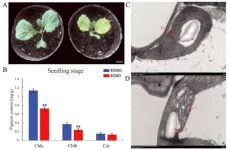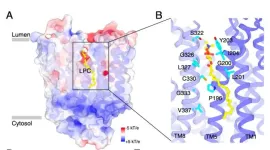(Press-News.org) Research Highlights:
A data analysis projected that South Asian adults living in the United Kingdom may experience elevated blood pressure nine years earlier than East Asian adults on average.
The largest blood pressure disparities between South Asian and East Asian adults were projected to be in 18-39-year-old men and 40–64-year-old women.
The projected increase in systolic blood pressure in middle age East Asian adults was linked to a nearly 2.5 times higher risk for heart disease caused by blocked arteries and a nearly fourfold greater risk of stroke. Even at an older age, high systolic blood pressure predicted risk for all types of stroke.
Embargoed until 4 a.m. CT/5 a.m. ET Wednesday, February 12, 2025
DALLAS, Feb. 12, 2025 — South Asian and East Asian adults living in the United Kingdom may have distinct trajectories to develop high blood pressure over their life course, according to new research published today in Hypertension, an American Heart Association journal.
Researchers analyzed health records for more than 3,400 adults enrolled in the UK Biobank who self-identified as having South Asian or East Asian ethnicity. Previous research found that individuals with South Asian ancestry living in the United Kingdom had substantially higher risk of heart disease caused by blocked arteries, or atherosclerotic cardiovascular disease (ASCVD), compared with individuals with European ancestry, as well as that South Asian adults living in the United States had higher death rates from ASCVD compared with white adults. Here, researchers explored differences in long-term blood pressure patterns and their potential lifetime effects on cardiovascular disease of those differences between South Asian and East Asian adults.
“High blood pressure and its management varies widely across racial and ethnic populations, and the frequently used ‘Asian’ category hides those differences,” said lead study author So Mi Jemma Cho, Ph.D., a postdoctoral fellow at Massachusetts General Hospital and the Broad Institute of MIT and Harvard. “This is crucial considering that high blood pressure at a young age is a major contributor to premature heart disease risk and given the emerging initiatives to study distinct cardiometabolic profile across different Asian subpopulations.”
The study used data for South Asian and East Asian adults who had at least two blood pressure readings taken during primary care visits after age 18 years. Researchers tracked participants’ heart disease events, including heart attacks, stroke and peripheral artery disease, using hospitalization and outpatient care records. Building on these baseline differences, as well as risk factors including current smoking status, dietary score and a metric of social determinants of health, the researchers estimated participants’ blood pressure patterns at five-year increments and modeled their predicted relationships to cardiovascular disease risk.
The analysis found that:
South Asian adults underwent earlier and faster increases in blood pressure compared to East Asian adults. At age 30 years, the average projected systolic blood pressure was 124.9 mmHg in South Asian men and 107.4 mmHg in South Asian women compared to 120.7 mmHg and 105.7 mmHg in East Asian men and women.
On average, South Asian men were projected to reach a systolic (top number) blood pressure of 130 mmHg or higher, classified as high blood pressure by the 2017 ACC/AHA Guideline for the Prevention, Detection, Evaluation, and Management of High Blood Pressure in Adults, 10 years sooner than East Asian men (at 36 vs. 46 years). For women, the gap was 7 years (45 vs. 52 years).
The combined projection for South Asian men and women to reach a systolic blood pressure of 130 mmHg was age 40 years, compared to age 49 years for East Asian men and women—a 9-year difference.
For South Asian adults, high blood pressure observed in early adulthood was associated with higher lifetime cardiovascular disease risks. For East Asian adults, higher blood pressure in midlife was associated with higher atherosclerotic cardiovascular disease risk; even at ages 65 and older, high blood pressure was associated with heightened risk of stroke.
Each standard deviation increase in midlife systolic blood pressure in East Asian adults was linked to a nearly 2.5 times higher risk for ASCVD and a nearly fourfold greater risk of stroke. Systolic blood pressure in East Asian adults ages 65 years or older was significantly linked to all types of stroke risk.
Young adulthood diastolic blood pressure was strongly linked to peripheral artery disease in South Asian adults (2.18 times higher risk per standard deviation increase).
These findings were consistent when examining blood pressure trajectory based on genetic ancestry, rather than self-identified ethnicity.
“These findings demonstrate the need to tailor blood pressure screenings and treatment timing for different Asian subpopulations to advance personalized care and prevention strategies for historically understudied communities,” said senior study author Pradeep Natarajan, M.D., M.M.Sc., an associate professor at Harvard Medical School. “Distinct age-related blood pressure patterns provide valuable insights to better manage cardiovascular risks and improve care for diverse populations.”
Study details, background and design:
Health data was from the UK Biobank, a study of 503,325 adults living in the United Kingdom who were 40 to 69 years of age at enrollment between 2006 and 2010. The in-depth health and biomedical information was collected for participants registered in the United National Health Service with a U.K. general practitioner (similar to a primary care physician in the U.S.).
This analysis included 3,453 participants. 3,077 of the participants self-identified as originating from South Asia and 376 of participants self-identified as being from East Asia. 47% of the South Asian participants self-identified as women and 53% as men; 64.9% of East Asian participants self-identified as women and 35.1% as men.
The 2017 ACC/AHA Guideline for the Prevention, Detection, Evaluation, and Management of High Blood Pressure in Adults classifies high blood pressure as having top or bottom blood pressure measures greater than or equal to 130/80 mm Hg.
Within the UK Biobank, participants who self-identified as originating from India, Pakistan, Bangladesh, Bhutan, Maldives, Nepal or Sri Lanka are defined as South Asian. Participants who self-identified as originating from China are defined as East Asian.
Participants’ characteristics at UK Biobank enrollment included that:
South Asian adults had higher blood pressure readings and were at least three times more likely to be on antihypertensive medications compared to East Asian adults.
South Asian adults had higher body weight on average, measured by body mass index, with an average of 27.6 kg/m2 compared to 24.2 mg/m2 in East Asian adults.
South Asian adults had slightly lower levels of "bad" LDL cholesterol (128.1 vs. 133.4 mg/dL), likely because they were more frequently prescribed cholesterol-lowering medications (27.5% vs. 10.6%).
Outcomes and health records collected after enrollment found that:
High blood pressure affected nearly twice as many South Asian adults as East Asian adults by age 40 years.
South Asian adults were more likely to begin taking medication for high blood pressure three years sooner (age 53.7 vs. 56.9 years, and at an average SBP of 143 mmHg and 141 mmHg, respectively).
South Asian adults had four times the lifetime incidence of heart disease caused by blocked arteries than East Asian adults (3.5 vs. 0.9 per 1,000 person-years).
Key risk factors included in projections were: current smoking status, defined as lifetime smoking of at least 100 cigarettes and without indication of cessation at enrollment; dietary score was quantified based on self-recalled average intake of fruit, vegetable, whole grains, fish, dairy and vegetable oils, refined grains, meats, and sugar-sweetened beverages by the U.K. National Health Service’s Eatwell Guide; and socioeconomic status was determined using the Townsend Deprivation Index, which is based on occupation, car ownership, home ownership and household overcrowding.
The study’s limitations include that its findings may not apply to Asian people living outside the U.K., as differences in health care systems, living environments and cultural adaption could influence the results.
“The authors provide important evidence supporting that cardiovascular risk factors like hypertension are not uniformly experienced among the diverse communities that are frequently but inappropriately aggregated under the race label ‘Asian,’” said Nilay S. Shah, M.D., M.P.H., FAHA, chair of the Association’s 2024 scientific statement “Social Determinants of Cardiovascular Health in Asian Americans.” Shah, who was not involved in the study, is an assistant professor of cardiology and preventive medicine at Northwestern University Feinberg School of Medicine and a general and preventive cardiologist in the Bluhm Cardiovascular Institute of Northwestern, both in Chicago.
“It’s increasingly recognized that ethnicity is distinct from biological exposures like genetics. Given the authors’ ability to evaluate both, these findings showing that hypertension epidemiology varies by both self-identified Asian group ethnicity and genetic Asian ancestry should prompt greater exploration of differences in social risk factors that may explain the differences in hypertension and CVD outcomes among self-reported Asian ethnicity groups; simultaneously, the genetic composition leading to differences in hypertension epidemiology among Asian genetic ancestry groups remain to be more thoroughly understood,” Shah said.
“Ultimately, these findings from a U.K. population of Asian adults suggest a complex interplay of social factors and genetics resulting in varying experiences of hypertension in Asian populations. There is much, much more work to be done to understand cardiovascular risk factors and outcomes experienced by Asian populations.”
Co-authors, disclosures and funding sources are listed in the manuscript.
Studies published in the American Heart Association’s scientific journals are peer-reviewed. The statements and conclusions in each manuscript are solely those of the study authors and do not necessarily reflect the Association’s policy or position. The Association makes no representation or guarantee as to their accuracy or reliability. The Association receives funding primarily from individuals; foundations and corporations (including pharmaceutical, device manufacturers and other companies) also make donations and fund specific Association programs and events. The Association has strict policies to prevent these relationships from influencing the science content. Revenues from pharmaceutical and biotech companies, device manufacturers and health insurance providers and the Association’s overall financial information are available here.
Additional Resources:
Multimedia is available on the right column of release link https://newsroom.heart.org/news/high-bp-may-develop-at-different-ages-and-paces-in-east-south-asian-adults-in-the-uk?preview=14d738d687f204f79c59a7e28beaaa25
After February 12, 2025 view the manuscript online.
AHA news release: Interrelated social factors may affect cardiovascular health in Asian American subgroups (September 2024)
AHA resource: South Asians and heart disease: A House Calls headline
AHA journal article: Higher Risk of Heart Disease Among South Asians Calls for Targeted Interventions (March 2022)
Follow AHA/ASA news on X @HeartNews
Follow news from AHA’s Hypertension journal @HyperAHA
###
About the American Heart Association
The American Heart Association is a relentless force for a world of longer, healthier lives. Dedicated to ensuring equitable health in all communities, the organization has been a leading source of health information for more than one hundred years. Supported by more than 35 million volunteers globally, we fund groundbreaking research, advocate for the public’s health, and provide critical resources to save and improve lives affected by cardiovascular disease and stroke. By driving breakthroughs and implementing proven solutions in science, policy, and care, we work tirelessly to advance health and transform lives every day. Connect with us on heart.org, Facebook, X or by calling 1-800-AHA-USA1.
END
High BP may develop at different ages and paces in East & South Asian adults in the UK
South Asian adults in the United Kingdom may face high blood pressure-related heart risks earlier in life, while East Asian adults see risks rise in later years, according to a new study in Hypertension Journal
2025-02-12
ELSE PRESS RELEASES FROM THIS DATE:
Meet the newly discovered brain cell that allows you to remember objects
2025-02-12
Take a look around your home and you’ll find yourself surrounded by familiar comforts—photos of family and friends on the wall, well-worn sneakers by the door, a shelf adorned with travel mementos.
Objects like these are etched into our memory, shaping who we are and helping us navigate environments and daily life with ease. But how do these memories form? And what if we could stop them from slipping away under a devastating condition like Alzheimer’s disease?
Scientists at UBC’s faculty of medicine have ...
Engineered animals show new way to fight mercury pollution
2025-02-12
Australian scientists have found an effective new way to clean up methylmercury, one of the world’s most dangerous pollutants, which often builds up in our food and environment because of industrial activities such as illegal gold mining and burning coal. The discovery, published in Nature Communications on 12 February 2025, could lead to new ways of engineering animals to protect both wildlife and human health.
The research team from Macquarie University's Applied BioSciences, CSIRO, Macquarie Medical School, and the ARC Centre of Excellence in Synthetic Biology, has successfully genetically modified fruit flies and zebrafish to transform methylmercury into a ...
The 3,000-year coral reef shutdown: a mysterious pause and a remarkable recovery
2025-02-12
New study reveals that coral reefs in the Gulf of Eilat experienced a surprising 3,000-year "shutdown" in growth, from about 4,400 to 1,000 years ago, likely due to a temporary drop in sea level that could have been caused by global cooling. This phenomenon, which aligns with similar reef interruptions in Mexico, Brazil, and Australia, suggests a widespread environmental shift during that period. Despite the long pause, the reef eventually recovered, with coral species reappearing from deeper ...
Worm surface chemistry reveals secrets to their development and survival
2025-02-12
A new study has revealed the clearest-ever picture of the surface chemistry of worm species that provides groundbreaking insights into how animals interact with their environment and each other. These discoveries could pave the way for strategies to deepen our understanding of evolutionary adaptations, refine behavioural research, and ultimately overcome parasitic infections.
Scientists from the University’s School of Pharmacy used an advanced mass spectrometry imaging system to examine the nematodes Caenorhabditis elegans and Pristionchus pacificus, aiming to characterise species-specific surface chemical ...
Splicing twins: unravelling the secrets of the minor spliceosome complex
2025-02-12
In human cells, only a small proportion of the information written in genes is used to produce proteins. How does the cell select this information? A large molecular machine called the spliceosome continuously separates the coding and non-coding regions of our genes – and it's doing this even as you read these lines.
The spliceosome is critical for the proper functioning of every cell, and numerous genetic disorders are linked to problems with spliceosome function. In most eukaryotic cells, two types of ...
500-year-old Transylvanian diaries show how the Little Ice Age completely changed life and death in the region
2025-02-12
Glaciers, sediments, and pollen can be used to reconstruct the climate of the past. Beyond ‘nature’s archive,’, other sources, such as diaries, travel notes, parish or monastery registers, and other written documents – known at the ‘society’s archive’ – contain reports and observations about local climates in bygone centuries.
In contrast, the second half of the century was characterized by heavy rainfall and floods, particularly in the 1590s.
The western parts of the European continent cooled significantly when in the 16th century a period known as the ‘Little Ice Age’ intensified. During the second ...
Overcoming nicotine withdrawal: Clues found in neural mechanisms of the brain
2025-02-12
According to the World Health Organization (WHO), over 22% of the global population smokes, with more than 9 million smoking-related deaths reported annually. Effective treatments to alleviate nicotine withdrawal symptoms caused by smoking cessation are essential for successful smoking cessation. Currently, approved treatments for nicotine withdrawal include Bupropion and Varenicline, but there is a pressing need for new therapeutic options to improve smoking cessation success rates.
The research team led by Dr. Heh-In Im at the Center for Brain Disorders of the Korea Institute of Science and Technology (KIST) has identified a novel brain region and neural mechanism ...
Survey: Women prefer female doctors, but finding one for heart health can be difficult
2025-02-12
EMBARGOED UNTIL WEDNESDAY, FEBRUARY 12, 2025
Mountain View, CA (Feb. 12, 2025) – According to the U.S. Physician Workforce Data Dashboard, only about 17% of cardiologists are women, ranking as one of the lowest specialties among female physicians, yet heart disease remains the number one killer of women, accounting for one in five female deaths. El Camino Health is innovating a solution to address the unique symptoms and risk factors of heart disease in women.
A new national survey conducted by El Camino Health found women (59%) are ...
Leaf color mysteries unveiled: the role of BoYgl-2 in cabbage
2025-02-12
A new study has uncovered a novel P-type PPR protein, BoYgl-2, which plays a crucial role in chloroplast RNA editing and chlorophyll biosynthesis in cabbage. This discovery sheds new light on the molecular mechanisms governing leaf color formation and chloroplast development, filling a significant knowledge gap in plant physiology. By identifying a spontaneous yellow-green leaf mutant and deciphering the function of BoYgl-2, the research paves the way for innovative crop breeding strategies that could enhance plant productivity and agricultural sustainability.
Leaf color is more than just an aesthetic trait—it is a vital agronomic characteristic ...
NUS Medicine study: Inability of cells to recycle fats can spell disease
2025-02-12
Accumulation of fat molecules is detrimental to the cell. Researchers from the Yong Loo Lin School of Medicine, National University of Singapore (NUS Medicine), have made a breakthrough in understanding how our cells manage to stay healthy by recycling important fat molecules. Their study, published in the journal Proceedings of the National Academy of Sciences (PNAS), reveals how a protein called Spinster homolog 1 (Spns1) helps transport fats out of cell compartments known as lysosomes.
Led by Associate Professor Nguyen Nam Long, from the Department of Biochemistry and Immunology Translational Research Programme (TRP) at NUS Medicine, the team found that Spns1 is like a cellular ...
LAST 30 PRESS RELEASES:
The Ceramic Society of Japan’s Oxoate Ceramics Research Association launches new international book project
Heart-brain connection: international study reveals the role of the vagus nerve in keeping the heart young
Researchers identify Rb1 as a predictive biomarker for a new therapeutic strategy in some breast cancers
Survey reveals ethical gaps slowing AI adoption in pediatric surgery
Stimulant ADHD medications work differently than thought
AI overestimates how smart people are, according to HSE economists
HSE researchers create genome-wide map of quadruplexes
Scientists boost cell "powerhouses" to burn more calories
Automatic label checking: The missing step in making reliable medical AI
Low daily alcohol intake linked to 50% heightened mouth cancer risk in India
American Meteorological Society announces Rick Spinrad as 2026 President-Elect
Biomass-based carbon capture spotlighted in newly released global climate webinar recording
Illuminating invisible nano pollutants: advanced bioimaging tracks the full journey of emerging nanoscale contaminants in living systems
How does age affect recovery from spinal cord injury?
Novel AI tool offers prognosis for patients with head and neck cancer
Fathers’ microplastic exposure tied to their children’s metabolic problems
Research validates laboratory model for studying high-grade serous ovarian cancer
SIR 2026 delivers transformative breakthroughs in minimally invasive medicine to improve patient care
Stem Cell Reports most downloaded papers of 2025 highlight the breadth and impact of stem cell research
Oxford-led study estimates NHS spends around 3% of its primary and secondary care budget on the health impacts of heat and cold in England
A researcher’s long quest leads to a smart composite breakthrough
Urban wild bees act as “microbial sensors” of city health.
New study finds where you live affects recovery after a hip fracture
Forecasting the impact of fully automated vehicle adoption on US road traffic injuries
Alcohol-related hospitalizations from 2016 to 2022
Semaglutide and hospitalizations in patients with obesity and established cardiovascular disease
Researchers ‘listen in’ to embryo-mother interactions during implantation using a culture system replicating the womb lining
How changing your diet could help save the world
How to make AI truly scalable and reliable for real-time traffic assignment?
Beyond fragmented markets: A new framework for efficient and stable ride-pooling
[Press-News.org] High BP may develop at different ages and paces in East & South Asian adults in the UKSouth Asian adults in the United Kingdom may face high blood pressure-related heart risks earlier in life, while East Asian adults see risks rise in later years, according to a new study in Hypertension Journal








